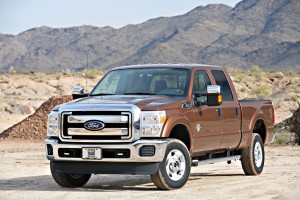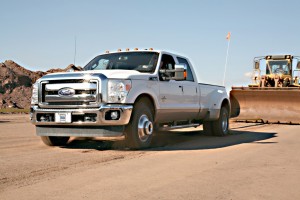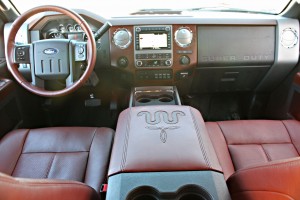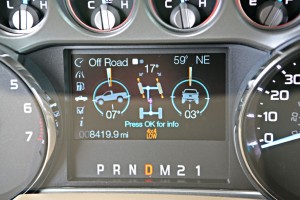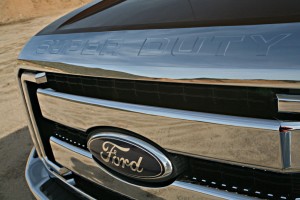Sitting high behind the wheel of the 2011 F-250 Super Duty 4×4 King Ranch, I caught myself wishing for dollar-a-gallon diesel. At least then I’d have a semblance of an excuse for owning a truck that weighs over three tons and can yank an apartment building off its foundation.
The newest version of Ford’s over-8500 pound pickup is inexplicably cool to drive, especially if you’re towing five tons or crawling over boulders the size of Fiats. It’s not bad on-road either. But the reality is this isn’t the 1990s. Few people without a practical reason to own a heavy-duty truck will do so just because it looks good in the driveway.
Ford touts the 2011 Super Duty as all-new, but it isn’t. Nor does it need to be. The last major Super Duty makeover was in 2008, so it’s not like the current model was a dinosaur.
The biggest changes happened under the hood. There are two all-new engines (that really are all-new), as well as an all-new six-speed automatic transmission. Additionally, some of the sheet metal is different and the interiors are mildly freshened.
The timing for this refresh is important given that Dodge introduced their new 2010 Ram Heavy Duty at the end of last year, and that GM showed their beefier 2011 Silverado and Sierra HD models at the Chicago Auto Show. Given the company’s momentum, Ford wasn’t about to wait another two or three years to unleash their best new truck technologies. As the company has seen with their rollouts of the Escape, Mustang, Fusion, and Edge, buyers positively respond to meaningful product refreshes.
Most Super Duty owners purchase these trucks to use as tools. As any self-respecting guy knows, the stronger the tool, the better. Given the age of the old 5.4-liter Triton V-8, the Super Duty was in need of a better gasoline engine. Engineers told us that the Triton was at the end of its development lifecycle, so they developed an all-new engine architecture.
The new 6.2-liter V-8 engine puts out 385 hp and 405 lb-ft torque. Important tech features include single-overhead cams, variable valve timing and dual spark plugs per cylinder. Anticipating the arrival of affordable E85, the new engine is alcohol capable. Economy is improved considerably over the Triton.
The 6.2-liter’s power enables it to replace the 5.4-liter and the 6.8-liter V-10 in all F-250 and F-350 applications, the volume-leaders of the Super Duty line. Limited production of the V-10 continues for F-450 and F-550 models. Some fleets still prefer the power/value equation of the last remaining member of Ford’s modular engine family.
The 6.2-liter is the base Super Duty engine, but a majority of buyers will opt for the all-new 6.7-liter Power Stroke diesel engine. While the previous Power Stroke diesel was a cooperative effort between Ford and Navistar, the new diesel is an all-Ford design. It produces 390 horsepower and 735 pound-feet of torque(!).
The core of the engine is a deep-skirted V-8 block of compacted graphite iron, which Ford claims is about two times stronger than traditional cast iron. Lightweight four-valve aluminum heads help shave 160 pounds off the engine’s total weight. Curiously, the air charge enters the heads on the outside of the V, with spent gasses exiting to the center of the valley. There, a Honneywell turbocharger waits for the rapidly expanding gasses. The blower features two outboard compressor wheels that form a sandwich around the impeller, delivering the performance of a twin-turbo system using only a single unit.
Bosch piezo injectors squirt fuel directly into the combustion chambers with up to 29,000 psi of force, and can parse out the diesel with as many as five sprays per combustion event to optimize power while reducing emissions and noise. While not as quiet as a Lexus LS460, the new Power Stroke is impressive nonetheless. The exhaust — that incorporates a urea aftertreatment — is also free from the offensive eau d’diesel.
Trucks over 8500-pounds are not subjected to EPA mileage tests, but Ford told us that their new diesel is significantly more efficient than the previous engine. During lead-footed driving, we averaged over 20 mpg. During an “economy run” segment of a press-only event, some trucks returned 29 mpg. The new Power Stroke costs $7,835 more than the 6.2-liter, the same upcharge as 2009.
The new engines deliver their torque to an all-new six-speed automatic transmission Ford calls the TorqShift. Electronic controls support the beefy mechanicals, enabling convenient manual shifting and locking out higher gears (to eliminate gear hunting in hilly terrain).
Some fleet owners will revel in the fact that the gearbox incorporates the ability to drive power-take-off devices. Doing the competition one better, Ford’s drive system enables the PTO to function anytime the engine is running, whether the truck is parked, idling, or in motion.
Other fleet owners will only care about the towing and payload capacities. The diesel setup in an F-250 can tow up to 14,000 pounds, half a ton more than the current Dodge and GM HD models. A properly equipped F-450 can handle up to a 24,400-pound trailer, 4,400 pounds more than the closest GM and a nearly three tons more than the Dodge HD.
Unlimited funds weren’t available for the 2011 Super Duty makeover, so compromises were necessary. Instead of all-new sheet metal, the big F-Series got a facelift from the A-pillars forward.
Apparently, the Power Stroke diesel is so big that it wouldn’t fit under the old design’s hood. This practical reality led to a new clamshell hood, two-bar grille, headlamp assemblies and front fenders. The look up front is good, but it tends to make the balance of the truck look old.
Inside, Ford updated the Super Duty’s tough-looking but comfortable interior in sensible ways. They utilized the comfortable front chairs out of the F-150, added a 4.2-inch LCD multi-function display to the IP of uplevel models, and designed a larger and more useful center console.
For a guy who actually likes driving a Lotus Elise on the street, the idea of enjoying a three-ton truck with recirculating-ball steering seems counterintuitive. It is, but there’s an invincible feeling that overtakes you when you’re behind the wheel of an F-Series Super Duty.
The remarkable driving characteristic about the new Super Duty is that it motors along as easily as today’s best light-duty pickups. New steering component geometry and revised suspension pieces help, as do the new-spec tires. Unladen it rides smoothly enough, but with half a ton in the bed, the ride turns downright supple.
On the road, the cab is passenger car quiet with either engine. Even when driving up a hill with the diesel’s turbo spooled up, there was never a need to talk over the engine noise. After driving the Ford back to back with a Dodge diesel, we found the Super Duty to be considerably quieter.
Regardless of engine, the trucks weren’t particularly quick, but they weren’t slow either. They tend to gather speed as opposed to bursting from the line.
Greater than 80-percent of Super Duty models are equipped with four-wheel drive. With features we’ve already seen on the Raptor (locking rear differential and Hill Decent Control), the truck’s off-road performance is considerable.
As for cost, Ford is generally holding the line on Super Duty pricing. The MSRP of a showroom-equipped 2011 F-250 XLT Crew Cab 4×4 diesel is priced as 2010 model.
Those who frequent factories, construction sites, and quarries have much to look forward to when the 2011 Super Duty hits dealerships later this spring. The rest of us can hope for diesel fuel to get cheaper than bottled water again.

